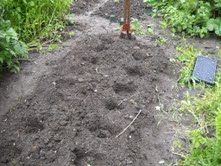Potatoes
Why is it that some people use nicknames for their children that are the names of vegetables or flowers? I’m sure you are familiar with “sweet pea” as a loving epithet (even for kids who are not sweet), or “pumpkin” for children who are neither round nor orange. The French, I am told, call their lovers “petit chou” which translates as “little cabbage”. But I have never heard anyone refer to a loved one as a potato. I wonder why, since potatoes are some of the easiest of vegetables to grow. I suggest you plant some now if you haven’t already.
I always wait until June to plant my potatoes, even though I could have done so in early May. I have found that later planting decreases problems with the Colorado potato beetle. That is an observation that I have previously reported here, and other gardeners have told me that when they planted later they, too, had fewer problems. I like to joke that by planting later all the beetles have gone next door.
If you have those nasty potato beetles, what should you do? The first line of defense is hand-picking. Look for the yellowish larvae or striped adults on leaves, and pop them in soapy water. Look for orange eggs on the underside of leaves, too. Check daily as soon as you have leaves on your plants. Don’t let a second generation get started, and you will have fewer problems.
You might also try an organic spray to control beetles. It is called Bt, which stands for Bacterium thuringiensis, a naturally–occurring soil bacterium that is available at garden centers as a powder. Dilute it with water and spray on leaves. When larvae eat leaves with the bacterium, a protein in the bacterium makes them sicken and die. It is not a contact poison, and will not harm us or our critters – nor will it kill adult beetles.
Potatoes are grown from sprouted pieces of last year’s crop. I generally save potatoes from one year to the next for planting. I went 25 years without buying potatoes until we got late blight in 2010. Blight can overwinter in potatoes, so it is not advisable to keep potatoes for planting if you’ve had late blight. If you want to plant potatoes, don’t buy them at the grocery store. Most conventional potatoes are treated to prevent them from sprouting. Buy ”seed potatoes” sold for planting – they are guaranteed disease-free.
I have tried three different planting techniques, and all work just fine. Let’s start with the easiest. Loosen the garden soil with a spading fork and stir in some bagged organic fertilizer and compost to the soil. Place on the soil surface some seed potatoes (or pieces of seed potatoes) with at least two “eyes” (buds). Then cover them with six inches of hay. Add more compost or soil on top of the hay so that no light gets to the chunks of potato. As the plants grow, add more hay and/or soil. The potatoes themselves grow above the seed potato; they need 6 inches of covering to have adequate space to develop.
I have also planted potatoes in a trench 6 inches deep. I loosen the soil in the trench and add some compost and bagged organic fertilizer. I place the seed potatoes 8 to 12 inches apart, push them into the loose soil, and cover them with 2 inches of soil. As they grow I add more soil until the trench is full. Some people hill up the soil over the trench to create even more growing space.
The third way to plant is to use a post hole digger. Dig holes 6 to 9 inches deep, add compost and fertilizer in the bottom of the hole and stir. Place your potato in the hole and cover with 2 inches of soil. As the potato vine grows, it is easy to push a little soil down the hole – in fact, rain often does it for me.
If you mulch your plants with straw or hay it will help keep down the weeds and keep the soil lightly moist. I wait to mulch until plants are a foot tall.
There are many varieties of potatoes available to choose from. One of the most productive is Kennebec, the classic white Maine potato. Also very good is Red Pontiac, which has red skins and a white interior. Both are excellent keepers, staying tasty all winter and into the spring. I also grow purple-skinned potatoes; they are called All Blue or Peruvian Blue, though they are smaller and less productive than some. And I usually grow Yukon Gold, a yellow-fleshed potato that is very tasty and quite productive. Fingerling potatoes are tasty, but much less productive than those listed above.
Harvesting potatoes is one of the high points of my garden year. I start in mid- to late summer, stealing a few by reaching down under a plant and pulling up a potato or two for dinner, but not disturbing the plant. Digging potatoes in the fall is like digging for treasure, and is great to do with kids.
So plant a few potatoes this summer – and start a new trend by calling your loved one your “little potato”. As far as I am concerned, that would be a compliment!
Henry Homeyer is a gardening consultant and the author or 4 gardening books. His Web address is www.Gardening-Guy.com.




